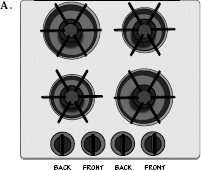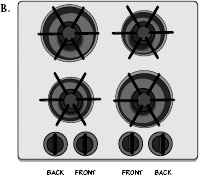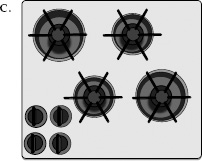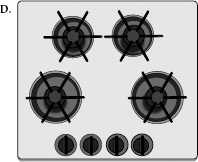Read The Design of Everyday Things Online
Authors: Don Norman
The Design of Everyday Things (22 page)
Mapping, a topic from
Chapter 1
, provides a good example of the power of combining knowledge in the world with that in the head. Did you ever turn the wrong burner of a stove on or off? You would think that doing it correctly would be an easy task. A simple control turns the burner on, controls the temperature, and allows the burner to be turned off. In fact, the task appears to be so simple that when people do it wrong, which happens more frequently than you might have thought, they blame themselves: “How could I be so stupid as to do this simple task wrong?” they think to themselves. Well, it isn't so simple, and it is not their fault: even as simple a device as the everyday kitchen stove is frequently badly designed, in a way that guarantees the errors.
Most stoves have only four burners and four controls in one-to-one correspondence. Why is it so hard to remember four things?
In principle, it should be easy to remember the relationship between the controls and the burners. In practice, however, it is almost impossible. Why? Because of the poor mappings between the controls and the burners. Look at
Figure 3.2
, which depicts four possible mappings between the four burners and controls.
Figures 3.2A
and
B
show how not to map one dimension onto two.
Figures 3.2C
and
D
show two ways of doing it properly: arrange the controls in two dimensions (C) or stagger the burners (D) so they can be ordered left to right.




FIGURE 3.2.
  Â
Mappings of
Stove Controls with Burners.
With the traditional arrangement of stove burners shown in
Figures A
and
B
, the burners are arranged in a rectangle and the controls in a linear line. Usually there is a partial natural mapping, with the left two controls operating the left burners and the right two controls operating the right burners. Even so, there are four possible mappings of controls to burners, all four of which are used on commercial stoves. The only way to know which control works which burner is to read the labels. But if the controls were also in a rectangle (
Figure C
) or the burners staggered (
Figure D
), no labels would be needed. Learning would be easy; errors would be reduced.
To make matters worse, stove manufacturers cannot agree upon what the mapping should be. If all stoves used the same arrangement of controls, even if it is unnatural, everyone could learn it once and forever after get things right. As the legend of
Figure 3.2
points out, even if the stove manufacturer is nice enough to ensure that each pair of controls operates the pair of burners on its side, there are still four possible mappings. All four are in common use. Some stoves arrange the controls in a vertical line, giving even more possible mappings. Every stove seems to be different. Even different stoves from the same manufacturer differ. No wonder people have trouble, leading their food to go uncooked, and in the worst cases, leading to fire.
Natural mappings are those where the relationship between the controls and the object to be controlled (the burners, in this case) is obvious. Depending upon circumstances, natural mappings will employ spatial cues. Here are three levels of mapping, arranged in decreasing effectiveness as memory aids:
      Â
â¢
 Â
Best mapping:
Controls are mounted directly on the item to be controlled.
      Â
â¢
 Â
Second-best mapping:
Controls are as close as possible to the object to be controlled.
      Â
â¢
 Â
Third-best mapping:
Controls are arranged in the same spatial configuration as the objects to be controlled.
In the ideal and second-best cases, the mappings are indeed clear and unambiguous.
Want excellent examples of natural mapping? Consider gesture-controlled faucets, soap dispensers, and hand dryers. Put your hands under the faucet or soap dispenser and the water or soap appears. Wave your hand in front of the paper towel dispenser and out pops a new towel, or in the case of blower-controlled hand dryers, simply put your hands beneath or into the dryer and the drying air turns on. Mind you, although the mappings of these devices are appropriate, they do have problems. First, they often lack signifiers, hence they lack discoverability. The controls
are often invisible, so we sometimes put our hands under faucets expecting to receive water, but wait in vain: these are mechanical faucets that require handle turning. Or the water turns on and then stops, so we wave our hands up and down, hoping to find the precise location where the water turns on. When I wave my hand in front of the towel dispenser but get no towel, I do not know whether this means the dispenser is broken or out of towels; or that I did the waving wrong, or in the wrong place; or that maybe this doesn't work by gesture, but I must push, pull, or turn something. The lack of signifiers is a real drawback. These devices aren't perfect, but at least they got the mapping right.
In the case of stove controls, it is obviously not possible to put the controls directly on the burners. In most cases, it is also dangerous to put the controls adjacent to the burners, not only for fear of burning the person using the stove, but also because it would interfere with the placement of cooking utensils. Stove controls are usually situated on the side, back, or front panel of the stove, in which case they ought to be arranged in spatial harmony with the burners, as in
Figures 3.2 C
and
D.
With a good natural mapping, the relationship of the controls to the burner is completely contained in the world; the load on human memory is much reduced. With a bad mapping, however, a burden is placed upon memory, leading to more mental effort and a higher chance of error. Without a good mapping, people new to the stove cannot readily determine which burner goes with which control and even frequent users will still occasionally err.
Why do stove designers insist on arranging the burners in a two-dimensional rectangular pattern, and the controls in a one-dimensional row? We have known for roughly a century just how bad such an arrangement is. Sometimes the stove comes with clever little diagrams to indicate which control works which burner. Sometimes there are labels. But the proper natural mapping requires no diagrams, no labels, and no instructions.
The irony about stove design is that it isn't hard to do right. Textbooks of ergonomics, human factors, psychology, and industrial engineering have been demonstrating both the problems and the
solutions for over fifty years. Some stove manufacturers do use good designs. Oddly, sometimes the best and the worst designs are manufactured by the same companies and are illustrated side by side in their catalogs. Why do users still purchase stoves that cause so much trouble? Why not revolt and refuse to buy them unless the controls have an intelligent relationship to the burners?
The problem of the stovetop may seem trivial, but similar mapping problems exist in many situations, including commercial and industrial settings, where selecting the wrong button, dial, or lever can lead to major economic impact or even fatalities.
In industrial settings good mapping is of special importance, whether it is a remotely piloted airplane, a large building crane where the operator is at a distance from the objects being manipulated, or even in an automobile where the driver might wish to control temperature or windows while driving at high speeds or in crowded streets. In these cases, the best controls usually are spatial mappings of the controls to the items being controlled. We see this done properly in most automobiles where the driver can operate the windows through switches that are arranged in spatial correspondence to the windows.
Usability is not often thought about during the purchasing process. Unless you actually test a number of units in a realistic environment, doing typical tasks, you are not likely to notice the ease or difficulty of use. If you just look at something, it appears straightforward enough, and the array of wonderful features seems to be a virtue. You may not realize that you won't be able to figure out how to use those features. I urge you to test products before you buy them. Before purchasing a new stovetop, pretend you are cooking a meal. Do it right there in the store. Do not be afraid to make mistakes or ask stupid questions. Remember, any problems you have are probably the design's fault, not yours.
A major obstacle is that often the purchaser is not the user. Appliances may be in a home when people move in. In the office, the purchasing department orders equipment based upon such factors as price, relationships with the supplier, and perhaps reliability: usability is seldom considered. Finally, even when the purchaser
is the end user, it is sometimes necessary to trade off one desirable feature for an undesirable one. In the case of my family's stove, we did not like the arrangement of controls, but we bought the stove anyway: we traded off the layout of the burner controls for another design feature that was more important to us and available only from one manufacturer. But why should we have to make a tradeoff? It wouldn't be hard for all stove manufacturers to use natural mappings, or at the least, to standardize their mappings.
Culture and Design: Natural Mappings Can Vary with Culture
I was in Asia, giving a talk. My computer was connected to a projector and I was given a remote controller for advancing through the illustrations for my talk. This one had two buttons, one above the other. The title was already displayed on the screen, so when I started, all I had to do was to advance to the first photograph in my presentation, but when I pushed the upper button, to my amazement I went backward through my illustrations, not forward.
“How could this happen?” I wondered. To me, top means forward; bottom, backward. The mapping is clear and obvious. If the buttons had been side by side, then the control would have been ambiguous: which comes first, right or left? This controller appeared to use an appropriate mapping of top and bottom. Why was it working backward? Was this yet another example of poor design?
